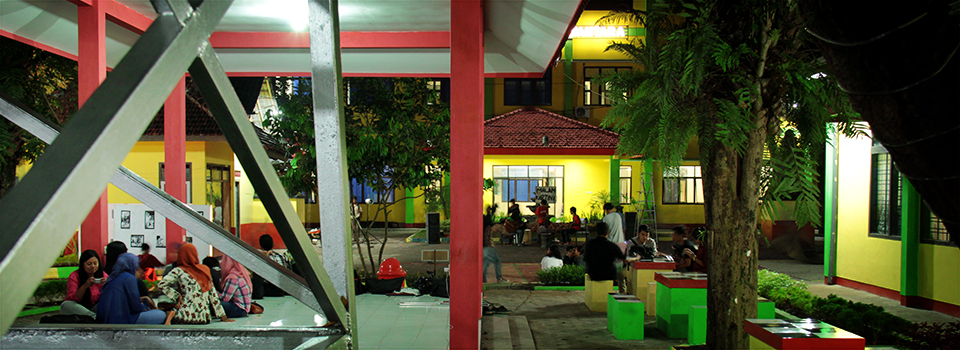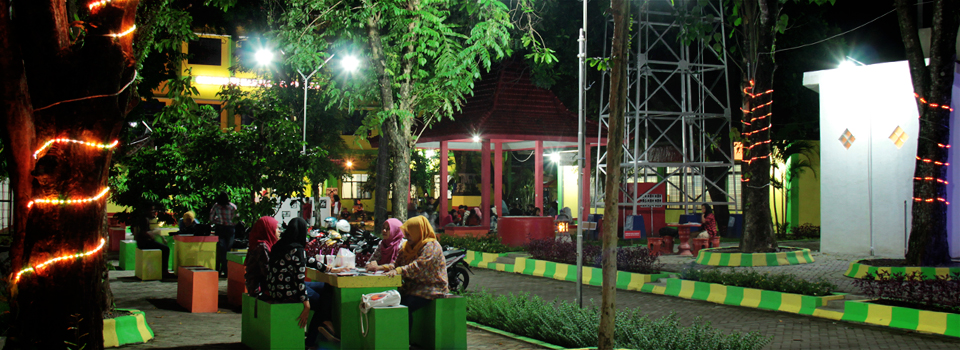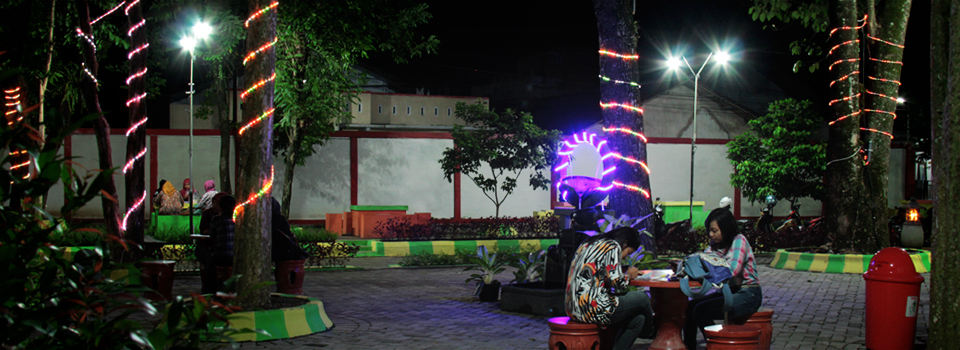Penulis
Sukarno
Pembimbing: Prof. Dr. Syamsul Hadi, SU, MA
ABSTRACT: The problems investigated in this descriptive study are (1) the realization of the metafunctional meanings of Friday sermon texts (FSTs), namely: the lexicogrammatical units which realize the meanings, (2) the description of the variables of the context of situation, which can be used to determine the FST register, and whether the interrelatedness of the variables have reflected the situational coherence, and (3) the statement of the generic structures of Friday sermons, and the reasons why the structure varies from one text to another. The purpose of this research is to identify the linguistic evidence, and the social context in FSTs, in turn it can be explained the gap between the linguistic theory and the reality found in FSTs. The data were collected by recording, and by taking the pictures of the speech events of four Friday sermon texts in Jember city, East Java. The analysis of data is conducted by deconstruction method, and the content analysis based on the discourse analysis model of systemic functional linguistics (SFL). The findings reveal the following results. First, in the scope of metafunctions, the experiential meaning is realized by the lexicogrammatical units at the group of words, at the level of clauses, and at the level of discourse. The interpersonal meaning is realized by the lexicogrammatical units by clause system, by pronoun system, by politeness system, and by vocative system. Finally, the textual meaning is realized by the lexicogrammatical units by theme system, by cohesive system, by code switching and code mixing for uniting the two languages in the text, by ungrammaticality for characterizing the spoken text, and by clause system, conjunction, and figurative language for realizing the rhetorical thrust. Secondly, in the scope of register, it shows that the variables of the context of situation are closely related to the social practice of Islamic religious services in Jember. In the field of discourse, the subject matter for each text varies, but they still b elong to the same (larger) field, namely „to maintain and develop the Islamic belief to achieve the happy life in the world, and in the world hereafter by following the Islamic teachings‟. The tenor refers to khatib, and jamaah (including bilal). The khatib have well-educated background. The jamaah, on the other hand, are heterogenic in the education, and social background (except the jamaah of Al-Hikmah Mosque, the Jember University campus mosque). Their role relations are equal; the contact happens face to face. The affective attitude of khatib towards the subject matters is positive. The mode of discourse shows that FST is monologue, and spoken text, with delayed response. The rhetorical mode refers to educative-persuasive text. It is also a cohesive text both for the text elements as well as the languages used in the text. The interrelatedness among the variables of the context of situation proved that FST was situationally coherence. Thirldly, in the term of the generic structure, the social-practice of the Friday sermon services varies from one text to another which is caused by the status of the elements, (2) the orders of the elements, and (3) the iterations of the elements. In relations with the actual structures, it is found that the generic structures with the second sermon not involving the Indonesian text dominates the Firday sermons in Jember. Although the generic structures of Friday sermons vary, they still show some similarities. Therefore, it is formulated the generic structure potential (GSP) for FSTs which can accommodate all the actual structures. Finally, the overall research findings show that FST is motivated and controlled by the dienic value, and actualized in the Islamic ideology, and practiced in the socio -cultural activities in the Islamic religious services. The influence of this value in FST is implemented in the linguistic domain, as demonstrated by the lexicogrammatical units realizing the metafunctions, in the context of situation as characterized by the variables of field, tenor, and mode, and in the genre, it is demonstrated by the generic structures. These distinctive features (register and the generic structures) make FST different from any other texts, and therefore FST can be claimed as a certain genre, namely „a Friday sermon genre‟ which is different from any other texts.
INTISARI: Tiga masalah utama penelitian deskriptif ini adalah (1) realisasi makna metafungsional teks khotbah Jumat (TKJ), yakni satuan-satuan leksikogramatika yang merealisasikan makna tersebut, (2) deskripsi ketiga variabel konteks situasi, sehingga dapat dirumuskan register, dan pembuktian kepaduan situasional, serta (3) pengungkapan wujud ragam struktur generik khotbah Jumat sebenarnya (SGKJS) sebagai implementasi konteks budaya pada TKJ, faktor pendorong keragaman SGKJ, dan perumusan struktur generik potensial untuk khotbah Jumat (SGPKJ). Penelitian ini bertujuan untuk mengidentifikasi ciri kebahasaan dan konteks sosial pada TKJ, sehingga dapat diungkap dan dijelaskan kesenjangan yang terjadi antara teori analisis wacana dengan fakta yang terjadi pada TKJ. Penyediaan data dilakukan dengan cara merekam suara dan gambar urutan peristiwa ujaran pada empat masjid di kota Jember, yang masing-masing melibatkan satu TKJ, sehingga total terdapat empat TKJ. Analisis data dilakukan dengan metode dekonstruksi dan metode analisis isi, mengikuti analisis wacana fungsional model LFB. Penelitian ini menunjukkan hasil sebagai berikut. Makna pengalaman direalisasikan oleh satuan leksikogramatika pada tataran kelompok kata, tataran klausa, dan tataran wacana. Makna interpersonal direalisasikan oleh satuan leksikogramatika melalui pilihan klausa, pilihan persona, pola kesantunan berbahasa, dan penggunaan salam dan sapaan. Makna tekstual direalisasikan oleh satuan leksikogramatika melalui pilihan tema, kepaduan antarunsur, kepaduan antarkode, ciri teks lisan direalisasikan oleh gramatikalitas, dan ciri ragam teks edukatif-persuasif direalisasikan melalui pilihan klausa, konjungsi, dan penggunaan majas. Kedua, hasil penelitian ini menunjukkan bahwa variabel konteks situasi TKJ berkaitan dengan suasana praktek sosial budaya keagamaan Islam di kota Jember yang mencakup medan, pelibat, dan wacana. Dalam hal medan, masing-masing TKJ menunjukkan pokok persoalan yang berbeda-beda, tetapi mereka masih masuk pada medan wacana yang sama, yakni „memelihara dan meningkatkan keimanan umat Muslim demi mencapi kehidupan yang berbahagia di dunia dan di akhirat‟. Yang menjadi pelibat adalah khatib dan jamaah. Khatib berlatarbelakang sebagai pendidik, berpendidikan S2, dan S3, dan berpengetahuan luas tentang ajaran agama Islam. Jamaah berlatarbelakang heterogen. Status hubungan antarpelibat setara yang tercermin melalui kesantunan berbahasa, dan sapaan penghormatan. Jamah juga bersikap santun, diam dan memperhatikan khotbah. Jenis kontak antarpelibat bersifat langsung, temporer, dan monologis. Sikap afektif khatib terhadap hal yang dibicarakan cenderung positif. Dari sisi variabel sarana, TKJ adalah teks lisan keagamaan Islam, dengan respon tunda, saluran suara. TKJ adalah teks yang padu dari sisi unsur-unsur teks, dan dari sisi dua jenis bahasa yang digunakan. TKJ adalah ragam teks edukatif-persuasif dengan retorika mendidik, mengingatkan, dan mempersuasi. Tautan antarunsur pada ketiga variabel konteks situasi sangat serasi, sehingga membuktikan bahwa TKJ telah menunjukkan kepaduan situasional. Ketiga, dari segi struktur generik, praktek sosial keagamaan khotbah Jumat di kota Jember beragam dari satu teks ke teks yang lainnya, yang dipengaruhi oleh: (1) status unsur, (2) urutan unsur, dan (3) frekuensi kemunculan unsur. Setiap ragam memiliki struktur tersendiri yang disebut SGKJS. Terkait dengan SGKJS, ditemukan bahwa SGKJS di Jember didominasi oleh struktur yang yang khotbah keduanya tanpa menggunakan bahasa Indonesia. Terlepas dari keragamannya, SGKJS-SGKJS masih menunjukkan unsur wajib yang sama, sehingga dirumuskan struktur generik potensial untuk khotbah Jumat (SGPKJ). Secara keseluruhan hasil penelitian ini menunjukkan bahwa TKJ dimotivasi oleh nilai nilai kontekstual yang distratakan sebagai nilai kultural, ideologi dan diniah. Pengaruh nilai-nilai ini direalisasikan pada tataran bahasa, seperti tampak pada ciri -ciri satuan leksikogramatika yang merealisasikan makna metafungsional, pada tataran konteks situasi diwujudkan oleh ciri-ciri situasi: medan, pelibat, dan sarana (register), dan pada tataran genre diwujudkan oleh struktur generik khotbah Jumat. Semua itu membuat TKJ memiliki ciri-ciri tertentu (unik), sehingga TKJ dapat dikategorikan sebagai teks khusus, yakni genre khotbah Jumat „a Friday sermon genre‟ yang berbeda dengan jenis teks lainnya.
sumber : http://digilib.uns.ac.id/
Baca Juga :
Disertasi Dr. Eko Crys Edrayadi, M.Hum
Disertasi Dr. Akhmad Haryono, M.Pd




